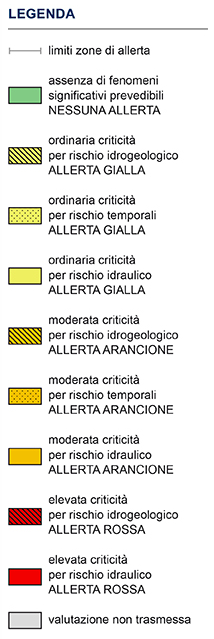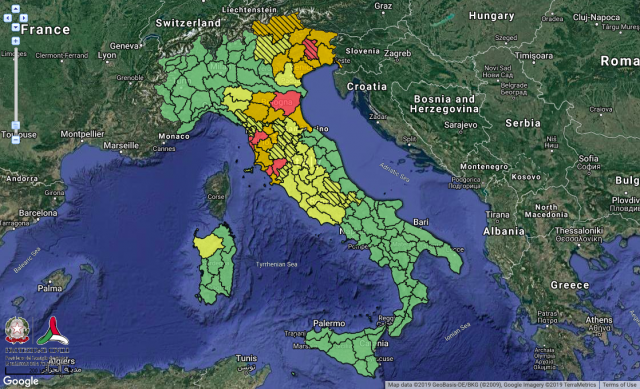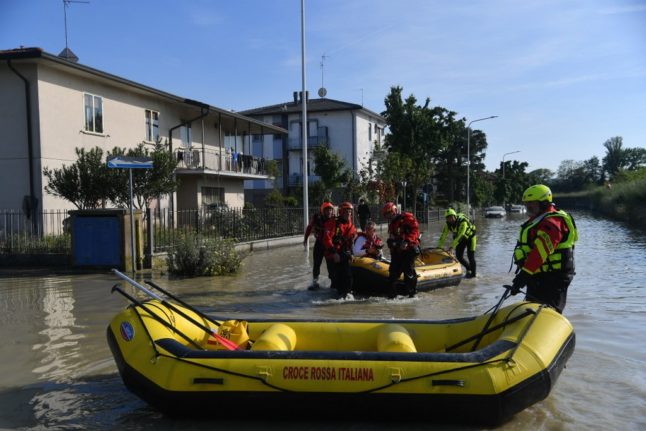Italy’s weather warning system
The Civil Protection Department, which warns the public about natural disasters in Italy and manages the response to them, issues 24-hour nationwide risk assessments every day at 4pm.
READ ALSO: Emergency in Italy: Who to call and what to say
There are three categories of weather alert:
- Yellow: usual risk.
- Orange: moderate risk.
- Red: high risk.
There are different types of alert within each level of risk: black stripes refer to “hydrogeological hazards” caused by groundwater, such as landslides, floods and coastal erosion, while black dots signal storms.
No markings means “hydraulic hazards” – the dangers related to rivers and streams, such as a waterway bursting its banks.
Green indicates that no alert is in place, while white shows the status is unknown.

You can find the Civil Protection Department’s daily risk assessment on its website (here), where you can access a searchable map showing the latest weather warnings in effect.

How to prepare for floods
Do some research about your area of Italy: if it has flooded in the past, the chances are it will again. some areas are especially flood-prone and are also being hit particularly hard by climate change. Find out ahead of time what type of risks you can expect and which areas are most vulnerable.
Floods can begin suddenly and escalate rapidly, so it’s best to be prepared. Move any valuable property out of the basement or garage and onto a higher floor, and keep an emergency kit – first aid supplies, bottled water, canned food, a torch, battery-powered radio and copies of important documents – readily accessible.
READ ALSO: How to stay safe while travelling in Italy
Discuss an emergency plan with the other members of your household and inform local authorities if anyone is likely to require particular help, for example people with mobility issues.
What to do if there’s a flood warning in your area
If you find yourself in an area at risk of flooding, the Civil Protection Department advises the following:
- Stay up to date by checking the latest news, weather forecast and guidance from your local authorities.
- Avoid rooms underground or at ground level, especially for sleeping.
- Close doors leading to basements, cellars and garages, and protect ground-level entrances with sandbags or other barriers.
- Only travel if absolutely essential, and plan your route to avoid low-lying areas, waterways or the coast.
What to do if flooding begins
- Switch off the gas and electricity, being careful not to touch electrical sockets with wet hands or feet.
- Head for the upper floors of your building, but take the stairs instead of the lift. Don’t go down to the basement or garage to salvage property or attempt to move your car.
- If you’re outdoors, avoid waterways, bridges, underpasses or embankments. Head for higher ground and if possible, stop your journey and take shelter in the nearest safe building.
- Avoid drinking tap water, which may be contaminated.
- Limit phone use to keep the lines clear for the emergency services.
- Follow the latest guidance from emergency services or local authorities, including evacuating your homes if necessary.
What to do once flooding stops
- Once you’re in a safe place, only leave it if authorities have told you it’s safe to do so.
- Avoid contact with flood waters, which may be contaminated or carry a risk of electric shock from damaged power cables.
- Throw away any food that has come into contact with flood waters.
- Exercise caution in areas where waters have retreated: the ground surface may have been weakened and could collapse.
- Check toilets, drains and septic tanks for damage before use.
- Check with local authorities and/or a technician before switching the power or gas back on or drinking water from the tap.
For more information about weather hazards in Italy, see the Civil Protection Department’s website.



 Please whitelist us to continue reading.
Please whitelist us to continue reading.
Member comments